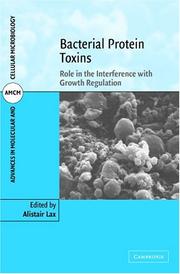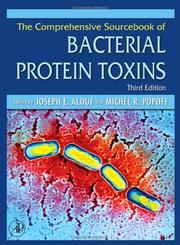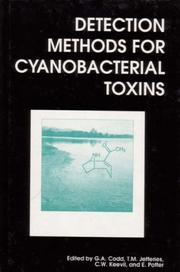| Listing 1 - 10 of 171 | << page >> |
Sort by
|
Periodical
Abstract | Keywords | Export | Availability | Bookmark
 Loading...
Loading...Choose an application
- Reference Manager
- EndNote
- RefWorks (Direct export to RefWorks)
Toxins --- Toxicology --- Toxins
Multi
ISBN: 9780128005897 0128005890 0128001887 9780128001882 Year: 2015 Publisher: Amsterdam Elsevier
Abstract | Keywords | Export | Availability | Bookmark
 Loading...
Loading...Choose an application
- Reference Manager
- EndNote
- RefWorks (Direct export to RefWorks)
The Comprehensive Sourcebook of Bacterial Protein Toxins 4th Edition, contains chapters written by internationally known and well-respected specialists. This book contains chapters devoted to individual toxins, as well as chapters that consider the different applications of these toxins. Considerable progress has been made in understanding the structure, function, interaction and trafficking into cells, as well as mechanism of action of toxins. Bacterial toxins are involved in the pathogenesis of many bacteria, some of which are responsible for severe diseases in human and animals, but can al
Book
Year: 2018 Publisher: Basel, Switzerland : MDPI - Multidisciplinary Digital Publishing Institute,
Abstract | Keywords | Export | Availability | Bookmark
 Loading...
Loading...Choose an application
- Reference Manager
- EndNote
- RefWorks (Direct export to RefWorks)
Increased awareness about environmental adverse effects of human activities has prompted the use of insecticides with low impact on systems associated to agriculture. Currently, the most successful biological products are based on protein toxins from the bacterial species Bacillus thuringiensis. Because of the remarkable properties of these proteins, their encoding genes were introduced into farming species (the so called Bt-crops), in such a way, that these plants are self-protected against some key insect pests. Despite the fact that a relatively large number of these toxins, with different toxicity ranges, have been described, it is still important to find new resources with novel capabilities to complement, or to replace in the future, the currently used ones. On another hand, it is important to continue studying their mode action in susceptible insects, and the changes occurred in resistant ones, to determine the most effective strategy for long lasting pest control. The focus of this Special Issue of Toxins is to provide updated information on the use of B. thuringiensis and their toxins on different field crops, the interactions of these toxins with other molecules, analyze the biochemical and molecular basis of emerging cases of resistance and, in general, to provide information which can contribute to an effective pest management with these toxins.
Book
Year: 2018 Publisher: Basel : MDPI AG - Multidisciplinary Digital Publishing Institute,
Abstract | Keywords | Export | Availability | Bookmark
 Loading...
Loading...Choose an application
- Reference Manager
- EndNote
- RefWorks (Direct export to RefWorks)
Annotation Bridging cellular membranes is a key step in the pathogenic action of both binary and pore-forming bacterial toxins. The former use their translocation domains, containing various structural motifs, to ensure efficient delivery of the toxic component into the host cell, while the latter act on the cellular membrane itself. In either case, the integrity of the membrane is compromised via targeted protein-lipid and protein-protein interactions triggered by specific signals, such as proteolytic cleavage or endosomal acidification. This Special Issue presents recent advances in characterizing functional, structural and thermodynamic aspects of the conformational switching and membrane interactions involved in the cellular entry of bacterial protein toxins. Deciphering the physicochemical principles underlying these processes is also a prerequisite for the use of protein engineering to develop toxin-based molecular vehicles capable of targeted delivery of therapeutic agents to tumors and other diseased tissues.

ISBN: 9780511546280 9780521820912 9780521177467 0511109687 9780511109683 0511109377 9780511109379 0511121180 9780511121180 0511546289 052182091X 1280162996 9781280162992 052182091X 1107136377 9786610162994 0511197225 0511298595 0521177464 Year: 2005 Publisher: Cambridge, UK New York Cambridge University Press
Abstract | Keywords | Export | Availability | Bookmark
 Loading...
Loading...Choose an application
- Reference Manager
- EndNote
- RefWorks (Direct export to RefWorks)
Bacterial toxins that act inside cells interact very specifically with key components of the cell and some even manipulate the cell in subtle ways for their own purposes. These potent toxins, described in this 2005 book, will be of interest to both microbiologists and cell biologists. Some of these toxins are conventional multidomain toxins that are self-programmed to enter cells. Others are delivered by type III mechanisms, often as a package of potent molecules. The molecular targets for all these toxins mediate signal transduction and the cell cycle to regulate the crucial processes of cell growth, cell division and differentiation. Thus these potent toxins are not only responsible for disease, but also provide a powerful set of tools with which to interrogate the biology of the cell. In addition such toxins may act directly to promote carcinogenesis and hence their study is also of interest in a wider context.
Bacterial toxins. --- Bacterial antigens --- Microbial toxins

ISBN: 9780120884452 0120884453 0080456987 9780080456980 9786610628469 1280628464 Year: 2006 Publisher: Amsterdam ; Boston : Elsevier,
Abstract | Keywords | Export | Availability | Bookmark
 Loading...
Loading...Choose an application
- Reference Manager
- EndNote
- RefWorks (Direct export to RefWorks)
This book describes the major achievements and discoveries relevant to bacterial protein toxins since the turn of the new century illustrated by the discovery of more than fifty novel toxins (many of them identified through genome screening). The establishment of the three-dimensional crystal structure of more than 20 toxins during the same period offers deeper knowledge of structure-activity relationships and provides a framework to understand how toxins recognize receptors, penetrate membranes and interact with and modify intracellular substrates.* Edited by two of the most highly re
Bacterial toxins. --- Bacterial antigens --- Microbial toxins
Periodical
Year: 2009 Publisher: Basel : Molecular Diversity Preservation International
Abstract | Keywords | Export | Availability | Bookmark
 Loading...
Loading...Choose an application
- Reference Manager
- EndNote
- RefWorks (Direct export to RefWorks)
Toxins --- Toxins, Biological. --- Toxicology. --- Animal Biochemistry
Book
ISBN: 3038421642 Year: 2016 Publisher: Basel, Switzerland : MDPI,
Abstract | Keywords | Export | Availability | Bookmark
 Loading...
Loading...Choose an application
- Reference Manager
- EndNote
- RefWorks (Direct export to RefWorks)
Annotation The special issue "Enterotoxins: Microbial Proteins and Host Cell Dysregulation" is comprised of research articles and reviews covering a diverse group of toxins that affect the gut and dysregulate host immune response in mechanistically different ways. Excellent in-depth reviews of staphylococcal superantigens and Clostridium perfringens toxins are the cornerstones of this issue. The present editorial highlights these papers grouped by toxin class and, within each toxin class, papers are discussed in order of publication date, with reviews appearing first, followed by original articles.
Enterotoxins. --- Enterotoxin --- Bacterial toxins

ISBN: 9781845698164 1845698169 9781855738027 9780851869612 Year: 1994 Publisher: Cambridge, England Royal Society of Chemistry
Abstract | Keywords | Export | Availability | Bookmark
 Loading...
Loading...Choose an application
- Reference Manager
- EndNote
- RefWorks (Direct export to RefWorks)
Cyanobacteria, or blue-green algae, commonly occur in a variety of water types throughout the world. A variable, but, high proportion of the cyanobacterial blooms and scums, which can develop annually in lakes, reservoirs, canals and slow-flowing rivers, contain potent toxins. Although animal poisonings and human health problems associated with the ingestion of, or contact with, cyanobacterial scums have long been recognized, a developing understanding of the health hazards posed by the toxins requires that reliable, sensitive, specific and convenient methods are available for their detection
Bacterial toxins --- Cyanobacteria --- Analysis
Book
Year: 2017 Publisher: Basel : MDPI - Multidisciplinary Digital Publishing Institute,
Abstract | Keywords | Export | Availability | Bookmark
 Loading...
Loading...Choose an application
- Reference Manager
- EndNote
- RefWorks (Direct export to RefWorks)
Many medically relevant bacteria cause severe human and animal diseases because they produce and release protein toxins that target mammalian cells. Because the toxin-induced cell damage is the reason for the clinical symptoms, the targeted pharmacological inhibition of the cytotoxic mode of action of bacterial toxins should prevent or cure the respective toxin-associated disease. Toxin inhibitors might be beneficial when the toxin acts in the absence of the producing bacteria (e.g., food poisoning), but also in combination with antibiotics in infectious diseases when the toxin-producing bacteria are present. The focus of this Special Issue of Toxins is on the development and characterization of novel inhibitors against bacterial toxins, e.g., toxin neutralizing antibodies, peptides or small compounds, as well as toxin pore blockers, which interfere with bacterial toxins and thereby protect cells from intoxication.
| Listing 1 - 10 of 171 | << page >> |
Sort by
|

 Search
Search Feedback
Feedback About UniCat
About UniCat  Help
Help News
News